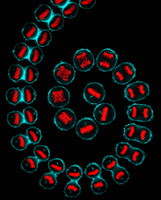How does the effect of drug-drug combinations relate to the cellular interactions of their targets ? Last year, Joseph Lehár and colleagues published
a paper in MSB looking into this question.

One way to study the effect of drug combinations on growth of a bacteria for example is to measure the inhibition of growth of all possible combinations of serially diluted doses of two combined drugs and plotting dose-matrices like the ones shown in
figure 1 of the paper and shown here adapted from the paper. In fig1A the authors show how the combined effect of increasing doses of two drugs inhibit the growth of a methicillin-resistant
Staphylococcus aureus strain. Light colors are equivalent to a strong inhibition of drug. One observation from this figure is that the two drugs can inhibit the growth of this strain in an additive fashion. The question the authors tried to address in this paper is how much does this sort of dose-matrix inform us about the possible interactions of the targets. The drugs could be interacting with the same target, different targets in the same pathway/complex, targets in different pathways both required for growth, etc.

In order to study this they first simulated an abstract metabolic network (using ODEs, see
model file in Sup) with two different pathways required for growth, with branched and linear blocks and one negative feedback (see
Fig3 in the paper). They simulated the effect of increasing drugs in their models by decreasing the enzyme activities of the simulated targets. For each possible drug-drug combination they then calculated the predicted dose-matrix effect on growth (pathway output). The observed that by fitting the obtained dose-matrices to 4 types of classical dose-matrix models (described in
Fig2) they could predict where in this network the two targets would more likely be.
As an example , two sequential targets in an unbranched section of the network embedded in an negative feedback produces a dose-matrix that best fits a potentiation model (shown here, adapted from Fig3).
Having established by simulations that there is information on the drug-matrices that relate to the interaction of their targets they then tested the effect of 10 known antifungal drugs on the sterol pathway (also well established) of
Candida glabrata. For each drug-drug combination they tried to fit the experimental dose matrices to the same 4 models and compared the best model fit to the expected for the position of the targets in the sterol pathway. For many cases (72%) the best model fit was the same as predicted from the sterol pathway model but only 54% of the best-fit models were unambiguous. There were some cases were drug-with-itself dose matrices (positive control) did not appear additive as expected. The authors mention that this is due to the "instability in the measured potency of a drug" but I am not sure why a drug-with-itself matrix would not be reproducible.
Finally the authors further tested this relation between drug combinations and target interactions by experimentally measuring drug dose-matrices for 94 drug/compounds in human(HCT116) tumor cells (
see text for details).
In summary, even if the prediction accuracy is far from perfect, this work shows that it should be possible to either:
1 - use known pathway models plus drug dose-matrices to improve prediction of the most likely targets of the drugs
2 - use known drug-target relationships plus the drug dose-matrices to predict the network connectivity
One obvious complication is the multiple drug targets for the same compound that would reduce the usefulness of the predictions. Some interesting extensions could be to test drug-drug interactions in KO strains or in combinations with RNAi knock-downs
or protein over-expressions.










